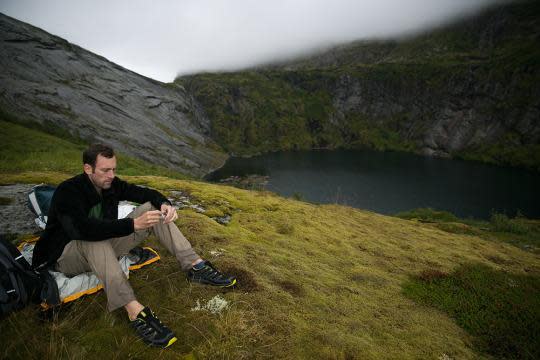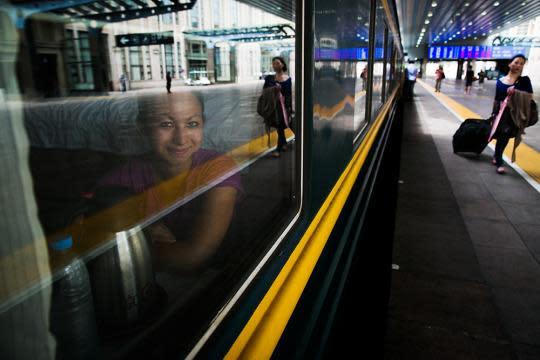How to See the World on $55 a Day (This Couple Did It!)

Mark and Britnee spent two years of calculated saving before taking a yearlong trip around the world. (Photo: Mark and Britnee Johnston)
Think you could never save enough money to quit your job and spend a year (or more!) traveling the world? Think again.
Just look at Mark and Britnee Johnston, your average young, married couple. They don’t have trust funds or make a crazy amount of money.
The Johnstons started saving and planning after they got married in 2012. At the time, they were pulling in a combined $85,000 a year. Based on research and a mock itinerary, Britnee calculated that they would need $40,000 for the year abroad plus $10,000 for extra spending and a starter fund for when they came back home. Unlike some other aspiring travelers who create Kickstarters or GoFundMe pages, Mark and Britnee didn’t want to ask people to pay for their “vacation.” Instead, they set aside chunks of their paychecks, went out less, and cut their grocery bill to meet their savings goal. “It was more fulfilling that way, knowing that we did this all on our own, that we earned it,” Britnee told Yahoo Travel.
So how did they do it? Over the course of 22 months, the pair saved, scrimped, budgeted, and planned. By making small, totally doable changes in their thinking and lifestyle. Changes you can make too.
Related: 10 Ways to Save Tons of Cash When You Travel in 2015
After saving the money, they broke their lease, quit their jobs (Britnee was a communications manager for a nonprofit and mark was a newspaper photo editor), and headed out on the trip of a lifetime. The couple started in Japan in May 2014 and traveled to 26 countries and 78 cities, ending in Peru in May of this year. (They recorded it all on their blog, One World One Year.)
Ultimately, they went about $8,000 over budget, spending about $48,000 for the year’s worth of adventures. However, that total includes a tax refund they received midtrip and some additional money that they had already saved for when they returned home. “I think we could have done it under $40,000, but we chose to keep a couple destinations in our itinerary,” Britnee said. “We only did it because we knew we had the extra money to do so.”
Here, the Johnstons share their most useful money-saving tips with Yahoo Travel. Consider these when planning your next big trip on a budget:
Before you go:
Tackle your debt first. It’s easier said than done, but it’s important — things like credit cards and loans can have such high interest rates it’s throwing away money. Mark and Britnee both graduated from college without student debt: Britnee applied for scholarships and grants to pay her way, and after serving in the Marine Corps, Mark got help from the GI bill. Then after getting married, they paid off their cars, which freed up an extra $500 a month. “To zero out our savings account just to take care of debt was difficult at first, but it was the wisest choice,” says Britnee.
Make travel your priority. Establishing travel as your ultimate goal and having a concrete plan to follow will put you in the mindset to save in order to achieve it, the couple says. “I think having specific numbers and a specific timeline really helps. I think if we never did that, it would have just always been a dream. Like, ‘Oh, we’ll travel some day,’” Britnee says.
Set aside money from each paycheck the moment you get paid. During the saving period, Mark and Britnee were raking in a combined salary of $80,000 per year, plus about $5,000 from freelance work. Every payday, they immediately put a portion of their nonfreelance checks into savings. The goal was for each of them to put aside $1,000 every month for two years in order to reach the $40,000 target. That was about half of each paycheck.

Luckily Mark and Britnee were already the outdoorsy type, which helped with saving money. (Photo: Britnee Johnston)
Learn to love affordable activities. The Johnstons are an outdoorsy pair, so they didn’t have to cut back on the biking and hiking in Utah. “The outdoors is free for anyone to enjoy, so we had that as our prime source of entertainment,” Mark said.
Streamline food shopping. The couple bought groceries every two weeks with a list of cheap ingredients that they stuck to, to avoid impulse buys. They had a cache of recipes they could make with what was on the list. (Though they did eat their share of frozen pizzas and tuna sandwiches.)
Brown bag it. Not only did the couple cook their own meals to save moolah, but they also saved leftovers for next-day lunches. They also cut back on going out, but kept up the activities that were important to them, like their climbing gym and their Netflix account, because paying a small subscription fee trumped paying for movies in theaters.
Buy big box. The Johnstons switched from local groceries to wholesale stores (think: Costco, BJ’s, Sam’s Club) to get more bang for the buck.
Skip the phone upgrades. Mark and Britnee stuck with the Android phones they had instead of jumping to buy new ones as soon as they came out. Bonus: They didn’t bring their phones with them to travel, so they weren’t held down by contracts, not to mention international calls and roaming fees. (They did, however, buy their first iPhones when they finally came back home.)
Take a break from shopping. Britnee said she rarely bought new clothes during their two years of saving.

Britnee rides a train in Mongolia. (Photo: Mark Johnston)
While you’re traveling:
Check flight prices as often as possible. Britnee said she was always on Skyscanner.net checking for cheap flights since airfares are constantly changing. One route they planned to take from New Zealand to Patagonia, Chile, cost about $2,000 when she first checked. Months later, after constant surveillance, she finally found tickets for $900 and jumped on the deal. (Note: Just don’t forget to clear your search history and cookies — according to some experts, you can get cheaper prices if the website thinks you’re searching for the first time.)
Related: 7 Ways You’re Booking Travel Wrong (and How to Fix Them)
Take public transportation. The Johnstons took public transport from airports to their hostels and to their sightseeing destinations. If the distance was manageable, they walked. The only time they rented a car was in Scotland. If you must take taxis, do so in Southeast Asia, where fares are cheap, Britnee advises.
Opt for alternative accommodations. Though they ran into some pricey hostels in Tokyo, for the most part, staying in hostels (many of which were under $30 a night) rather than hotels helped the Johnstons stay on budget. For an even cheaper price, they would stay in dorm rooms, but those were shared with other guests. It’s not for everyone, says Britnee, but if you’re game, it’s a good option. “It gave us less privacy and was sometimes less comfortable, but it helped save us money in the long run to keep on traveling.” Airbnb abroad is another one to try.
If your room has a kitchen, cook your own food. Being able to eat in is another money-saving perk to some hostels and homestays. Mark and Britnee also asked locals and other hostel guests where to find the cheapest authentic food so they wouldn’t miss out on the cultural experience of eating out. And they had the occasional fancy meal, like in Paris, for example.
Ask for discounts in person. Although they made most of their bookings online, Mark and Britnee switched things up when arranging their one-month stay at Patong Beach, in Thailand. They visited multiple hotels by foot to ask if they could get a better deal for their elongated stay. Eventually, one hotel located a few blocks from the beach let them stay for a rate that was half of what was listed on the website.
Use the first couple months to see where you need to make adjustments. During their first month or so of travel, the couple skimped a little too much on food. “We realized we needed to eat more,” Britnee said. Mark and Britnee only had the first two months’ itinerary completely arranged when they left, and then planned things on their laptop and iPad as they went. So don’t worry about having every move set in stone.
Ask for advice from other travelers. During their journey, the Johnstons met a man from Great Britain who told them to take Megabus, since some rides cost as little as £1 ($1.53). And in fact, they scored one-pound-each tickets from Paris to Barcelona. “We were able to save money by listening to other travelers’ ideas,” says Britnee.
Related: 10 Ways to Avoid Being Ripped Off While Traveling
Balance visits between expensive and cheap countries. Before spending two months in expensive areas in Europe, the Johnstons offset the cost by staying in Nepal for two months. The Southeast Asian country was one of the most affordable places they visited, since overnight stays in tea houses or a serving of curry often cost only a dollar. The most expensive country they saw was Norway, where they stayed in the Lofoten Islands for four days. Mark recalled that a fish sandwich would cost about $18. “We didn’t just stick to the cheap countries; there were some expensive countries we wanted to see, but we had to make sure they balanced each other out,” he says.

The Johnstons didn’t skip Paris in their travels around the world. (Photo: Mark Johston)
Pay attention to the financial details. Britnee kept a close eye on her checking account and noticed when she was charged with surprise fees. For example, when she and Mark were unexpectedly charged for a flat tire on their rental car, they refuted the charges and got their money back. “Paying attention to your credit card and the insurance you have on your card can be incredibly helpful,” said Mark.
Related: ’Tis the Season … for Spending. How to Afford That Trip You Really Want
Mark and Britnee have been home from their trip for three months now, and fortunately, the transition to normal life has been fairly smooth. Britnee landed a public relations job the week they returned and Mark transitioned to a marketing position. They got their own place in downtown Salt Lake City three weeks after coming home. But as an added bonus to all their travels, the experience has taught them to be happier with living with less. Their new apartment is about 600 square feet, which, after living in hostels for a year, feels spacious.
Although they’re not budgeting as strictly as they were before the trip, they’re still frugal by habit and may use the same saving tactics for, say, a down payment for a house. “I think the biggest lesson we learned in saving for this trip is we didn’t have to go to extremes to do it,” Mark said. After getting into that groove, hypersaving felt a lot easier than they thought it would be.
Britnee added, “Overall, I think we got a lot out of our money, and it was well worth it.”
WATCH: Top 5 Reasons to Go to Puerto Rico Now
Let Yahoo Travel inspire you every day. Hang out with us on Facebook, Twitter, Instagram, and Pinterest. Check out our original adventure travel series, “A Broad Abroad.”

